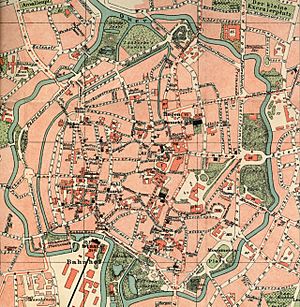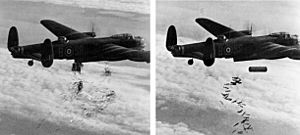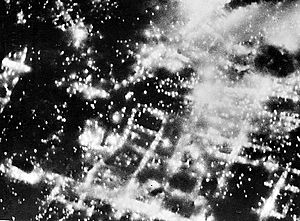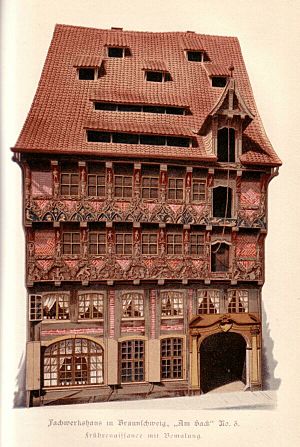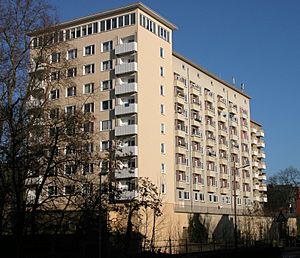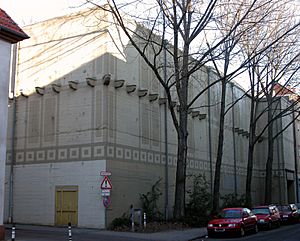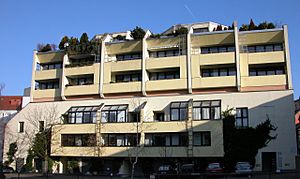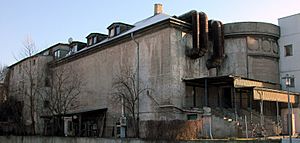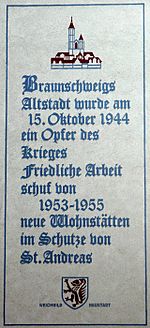Bombing of Braunschweig (October 1944) facts for kids
During World War II, the German city of Braunschweig (also called Brunswick in English) was attacked by Allied planes 42 times. The biggest attack happened on the night of October 14-15, 1944. This raid was part of a big plan called Operation Hurricane. Its goal was to show how powerful the Allied bombing forces were. The attack caused a huge fire that burned for two and a half days. More than 90 percent of the old city center was destroyed. This changed how Braunschweig looks even today.
Contents
Air Attacks on Braunschweig
The first time the British Royal Air Force (RAF) bombed Braunschweig was on August 17, 1940. Seven people died. Later, American bombers also targeted the city. Braunschweig was bombed regularly by the RAF at night and by American planes during the day. This included two attacks in February 1944 as part of "Big Week" raids.
The first large British attack was on January 14-15, 1944. Nearly 500 Lancaster bombers attacked. German fighter planes fought back strongly. Because Braunschweig was a small target, most bombs missed the city.
In August 1944, almost 400 heavy bombers tried an experimental raid. They used radar to bomb without marking the target first. The bombs were scattered, and some nearby towns were hit by mistake.
Between these big attacks, fast Mosquito planes made smaller, annoying raids. They also created diversions to confuse German defenses. In March 1945, one of the last attacks hit a chemical plant. This was part of a campaign against oil production.
Why Braunschweig Was a Target
Braunschweig had many important targets for the Allies. These included factories that made machines and weapons. There were also harbors, research centers, and railway stations. The German Research Centre for Aviation was also there. Nearby, there were also big factories like the Volkswagen plant.
The Big Attack: October 15, 1944
The RAF planned Operation Hurricane to show the Allies' air power. The main targets were big industrial areas like Duisburg and Cologne. Braunschweig was also chosen as a target. It had about 150,000 people in October 1944.
The plan for Braunschweig was to destroy it as much as possible. This was not just because of its factories. The goal was to make it unlivable. They wanted to create a huge fire, known as a firestorm. This was carefully planned based on scientific analysis.
On October 13, 1944, the weather forecast was good for bombing. The next day, Air Marshal Arthur "Bomber" Harris gave the orders. Braunschweig was given the secret code name Skate. All German cities had fish names for security reasons.
How the Attack Started
On October 14, 1944, RAF planes took off around 11 PM. The main force included 233 heavy Lancaster bombers. Each carried about 6 tons of bombs. Seven Mosquito bombers also joined them.
The bombers flew a route to avoid heavily defended areas. They used tricks to confuse German defenses. Many other planes flew simulated attacks on different cities. This made the Germans think other places were the main targets. Strips of tinfoil, called "Window," were dropped to jam German radar. This made it hard for German night fighters to find the bombers. Because of these tricks, the attack on Braunschweig was largely unopposed.
The air raid siren in Braunschweig sounded around 1:50 AM on October 15.
Marking the Target
Mosquito planes from the RAF marked the target for the main bombers. They used the Braunschweig Cathedral as a key point. A green flare was dropped over the cathedral area. Other Mosquitos dropped different colored flares, lighting up the target. These lit markers looked like "Christmas trees" to the Germans. The clear night and good target marking made conditions perfect for the attack from the British side.
The green marker helped the bomb aimers in all the planes. They flew over it from different directions and dropped their bombs.
Filming the Raid
The raid on Braunschweig was filmed by an RAF plane. It flew over the city at about 4,950 meters (16,240 feet). The attack started at 2:33 AM. The film showed fires spreading quickly. By the time the plane was over the city, the whole area was on fire.
The Firestorm Begins
About 847 tons of bombs were dropped on Braunschweig. First, about 12,000 explosive bombs, called "blockbusters," were dropped. These were meant to smash the old timber-framed houses. This would help start the firestorm. The blasts blew off roofs, broke windows, and damaged walls. They also cut off electricity and water. Firefighters and rescue workers had to hide in cellars.
After the explosive bombs, about 200,000 phosphorus and incendiary bombs were dropped. These bombs were designed to set the damaged buildings on fire. The goal was to create a firestorm that would burn for a long time.
The raid was over by about 3:10 AM, just 40 minutes after the first bombs fell.
The Firestorm's Power
A huge mass of hot air rose quickly from the fires. Cooler air rushed in to replace it, creating strong winds. These winds made the fires worse, making the winds even stronger. They were so powerful they could pick up small pieces of furniture and even toss people around.
Around 6:30 AM, the firestorm was at its strongest in the city center. About 150 hectares (370 acres) of historic Braunschweig were burning. The city's tallest church steeples, about 100 meters (328 feet) tall, could be seen burning far away. They also rained embers over the whole city. The ruins were full of unexploded bombs, which made it very hard for fire engines and rescue teams.
The city burned so brightly that the light could be seen from far away. Helpers and firefighters came from many surrounding towns to help.
Saving 23,000 People
Many fires in the city center quickly joined together into one huge blaze. In this area, there were six large bunkers and two air raid shelters. They were all very crowded with about 23,000 people hiding from the attack. While these people waited safely inside, a raging firestorm was outside.
The fire department soon realized the danger. The fire was getting hotter, and the oxygen in the bunkers was getting thinner. People would either suffocate inside or burn alive if they tried to escape through the fire.
The "Water Alley" Around 5:00 AM, before the firestorm was at its peak, a firefighter named Rudolf Prescher had an idea. He thought of building a "water alley." This would let the trapped people escape to safer parts of the city.
The water alley was a long hose kept under a constant mist of water. This mist protected the hose from the intense heat of the fire. Firefighters led the hose to the shelters. Small jets of water from holes in the hose created a continuous "rain zone."
The bunkers were reached around 7:00 AM. All 23,000 people were still alive. They were able to get out of the danger zone and reach safe areas like the museum park. Sadly, at one shelter, help came too late. 95 out of 104 people had suffocated by the time firefighters arrived. The firestorm in that area had used up almost all the oxygen.
What Happened After the Attack
A large part of Braunschweig's city center had about 800 old timber-framed houses. Many dated back to the Middle Ages. The old cathedral, used by the RAF as a guide, was left standing. Many other important historic buildings were badly damaged or completely destroyed.
| Building | Time Built | Condition After October 15, 1944 |
| Aegidienkirche (church) | 13th–15th centuries | Heavily damaged |
| Alte Waage | 1534 | Completely destroyed, rebuilt 1990–1994 |
| Andreas-Kirche (church) | about 1230 | Heavily damaged |
| Brunswick Palace | 1833–1841 | Heavily damaged, rebuilt 2008 |
| Brüdern-Kirche (church) | about 1361 | Heavily damaged |
| Dankwarderode Castle | 1887–1906 | Heavily damaged |
| Gewandhaus (cloth hall) | before 1268 | Heavily damaged |
| Haus Salve Hospes | 1805 | Heavily damaged |
| Katharinen-Kirche (church) | about 1200 | Heavily damaged |
| Liberei | 1412–1422 | Heavily damaged |
| Magnikirche (church) | about 1031 | Heavily damaged |
| Martini-Kirche (church) | about 1195 | Heavily damaged |
| Pauli-Kirche (church) | 1901/06 | Heavily damaged |
| Petri-Kirche (church) | before 1195 | Heavily damaged |
| Stechinelli-Haus | 1690 | Heavily damaged |
| Staatstheater | 1861 | Heavily damaged |
On the morning of October 16, Braunschweig was covered in thick smoke. A British plane sent to take photos couldn't see anything and had to return.
By the evening of October 17, the main fires were put out. But it took three more days, until October 20, to put out smaller fires. About 80,000 people in the city lost their homes.
The destruction was so bad that many people thought it was caused by a "thousand-bomber attack." Only later, when British military records were opened, did people learn that "only" 233 bombers had caused such damage.
Who Died?
The exact number of people who died in the October 15 attack is not known for sure. Estimates range from 484 to 640 deaths. 95 of these people suffocated in one shelter alone. Today, historians believe more than a thousand people died.
Compared to other German cities like Dresden or Hamburg, Braunschweig had fewer deaths. Experts say this was for a few reasons:
- Braunschweig was on a common flight path for bombers. People were used to alarms and knew how to quickly get to shelters.
- The city had many modern air raid bunkers, including tall, strong ones.
- The fire brigade's "water alley" saved 23,000 lives.
The RAF lost only one bomber that night due to anti-aircraft fire.
Braunschweig's Bunkers
Braunschweig had many modern air raid bunkers. Some were "Hochbunkers" (high-rise bunkers). These bunkers were very strong. A special type of safety standard for bunkers, called "Braunschweig Armour," was developed at the Technical University of Braunschweig. This standard was used for building air raid bunkers all over Germany.
Firefighters from Everywhere
About 4,500 firefighters worked to put out the fires. They came from up to 90 kilometers (56 miles) away. This included city fire brigades, volunteers, and factory firefighters. Their hard work helped prevent the city from being completely burned down.
After the War: Rebuilding Braunschweig
The official cleanup of rubble in Braunschweig began on June 17, 1946. It took 17 years, ending in 1963.
Braunschweig was rebuilt very quickly in the 1950s and 1960s. New homes were urgently needed. Since the city center was a wasteland of rubble, city planners decided to build a new, modern city. They wanted it to be friendly for cars. This meant that some historic city layouts were ignored. Old ruins were torn down quickly instead of being fixed. This led to a "second destruction" of Braunschweig's historic look.
The destruction of historic buildings, like the Braunschweig Palace in 1960, caused a lot of debate. People felt the city was losing its identity. Even today, some damaged or destroyed buildings are still being rebuilt, like the Braunschweig Palace in 2007.
Remembering the Past
A memorial in the Main Cemetery in Braunschweig holds the graves of many victims from the October 15, 1944, raid.
Every year on October 14-15, Braunschweig holds memorial events and exhibitions. These events remember the destruction of the city's historic old town. For example, on the 60th anniversary in 2004, there were many events, including a special concert at the Braunschweig Cathedral.
Images for kids


